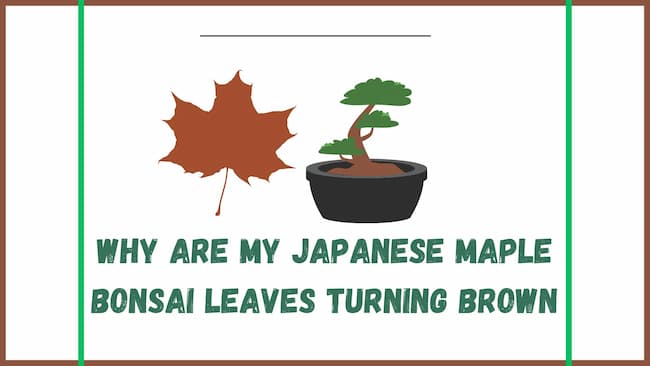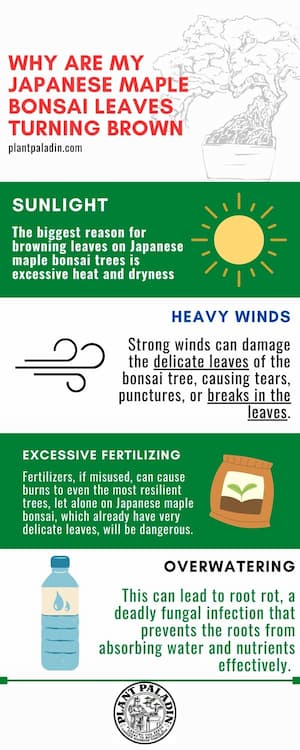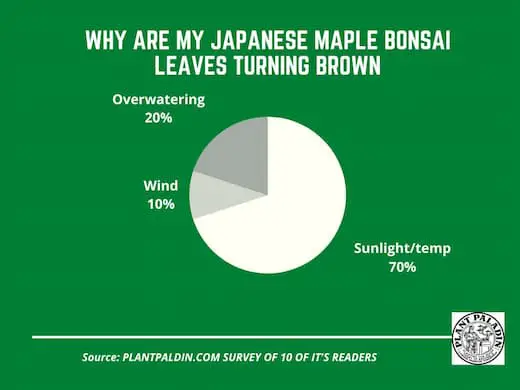This website is supported by its readers. If you click one of my links I may earn a commission. I am also a participant in the Amazon affiliates program and I will also earn a commission from qualified purchases.

Without a doubt, one of the most sought-after bonsai tree species has to be Japanese maple trees. With well over 1000 varieties, these trees look like miniature trees if cultivated correctly for bonsai. One widespread problem is browning leaves. A common question you might be asking is, why are my Japanese maple bonsai leaves turning brown?
The biggest reason for browning leaves on Japanese maple bonsai trees is excessive heat and dryness. Japanese Maple Bonsai prefer shady, cooler temperatures during the summer, and excessive heat and light will usually lead to brown, orange, or greying crispy leaves.
Ensure your Japanese maple bonsai is in partial shade during excessive heat and bright summers.
Water and check its needs for watering regularly to prevent any further damage.
So how exactly can you prevent your Japanese maple bonsai from developing brown leaves? And which sub-species of Japanese Maple are more susceptible to browning leaves? Keep reading to find out more.
Just a quick heads up, over the past three years of running Plantpaladin, hundreds of people have asked for product recommendations. As such, You can find my favorite indoor bonsai tree here (link takes you to Bonsaiboy), my favorite outdoor bonsai tree (link takes you to Bonsaiboy), or have a look at all the products I recommend here.
Why Are My Japanese Maple Bonsai Leaves Turning Brown
So recently, I purchased my Japanese maple bonsai and kept it in the shady spot in my garden, ready for the summer months.
Sadly, however, this tree has started to develop brown tips on the delicate leaves it contains.
Now, this could be better, especially having just purchased the tree.
As such, I contacted my local botanical gardens, visited a few gardening experts, and even surveyed five plant paladin readers to understand why my Japanese maple bonsai leaves are turning brown.
To summarize:
- The main reason Japanese Maple bonsai leaves turn brown is excessive dryness and leaf scorch.
- Brown leaves most commonly occur during the summer in dry temperatures.
- During these conditions, more moisture in Japanese maples gets lost to the environment, meaning you should water your Japanese Maple more frequently in warm, dry, sunny summers.
- Alternatively, aim to move your Japanese Maple indoors or keep it in a shady spot during bright conditions.
- For best results, ensure temperatures do not exceed 20 degrees Celcius or 68 degrees Fahrenheit for too long.
- Most Japanese maple bonsai trees will develop brown tips when moving to a new location. This is so they acclimatize in their first year. (This was the reason that my tree gained brown tips).
- After this, however, browning leaves will only develop if proper care is not given to the tree.
- Other significant causes for browning leaves are heavy winds: overwatering, pests, fungal infections, too much training, and excessive fertilizing.

What causes Japanese maple bonsai leaves to turn brown?
Now, as mentioned above, several significant factors can contribute to a Japanese maple bonsai tree developing bringing leaves, including:
- Too much sunlight
- High temperatures
- Heavy winds
- Excessive fertilizing
- Overwatering
- Pests
- Too much training
Let’s explore these in more detail:
Too much sunlight and high temperatures
So without a doubt, the biggest reason why Japanese Maple bonsai leaves turn brown is simply excessive sunlight and heat.
Japanese maple bonsai trees can be grown in most climates – in USDA zones 5-9 or, more specifically, in the ideal temperature range of 3 to 20 degrees C (37 to 68 Fahrenheit).
Should temperatures exceed 67F (20 degrees C) for a few days, the leaves will singe and turn brown and crispy.
This is mainly due to excessive sunlight burning the individual delicate leaves and the warm temperatures, which can cause the existing moisture to be sucked directly from the tree.
How to prevent it?
If you keep it outside, the best way to prevent this is to move your Japanese maple bonsai into the shade during the hottest parts of the day.
Alternatively, if you keep your Japanese Maple indoors, use a shade or blind during the brightest period to once again avoid any excessive light burns.
To manage the temperature and the water lost during this period, check your Japanese maple bonsai more frequently to see if it needs watering.
To do so, dip your finger in the topsoil.
If dry to the touch, then your Maple needs watering.
Alternatively, if your finger is wet, then avoid watering your bonsai.
Aim to check your Japanese maple bonsai tree twice daily to see if it needs watering during bright warm conditions outside the ideal temperature range.
Finally, ensure your Japanese Maple gets no more than 4 to 6 hours of direct sunlight daily.
Heavy winds
So not only do you have to worry about warm temperatures attacking and causing leaf scotch, but during the winter, strong winds can also have the same impact.
Strong winds can damage the delicate leaves of the bonsai tree, causing tears, punctures, or breaks in the leaves.
This damage can interrupt the flow of water and nutrients to the leaves, leading to their discoloration and eventual death, which manifests as brown leaves.
High winds can cause rapid dehydration of the bonsai tree, especially if the tree is already under stress due to insufficient water or humidity.
When the wind blows over the tree, it causes rapid moisture evaporation from the leaves and branches.
This leads to the drying and browning of the leaves.
As a result, the leaves may turn brown and eventually fall off.
How to prevent it?
Protecting the tree from wind damage is essential by placing it in a sheltered location or using a windbreak.
Additionally, ensuring proper watering and humidity levels can help prevent dehydration and stress on the tree, making it more resilient to the effects of wind.
Excessive fertilizing
Excessive fertilizing can also use the leaves of your Japanese maple bonsai to turn brown.
Fertilizers, if misused, can cause burns to even the most resilient trees, so using excessive fertilizers on Japanese maple bonsai, which already have very delicate leaves, means that you must take extra precautions.
How to prevent it?
Aim only to fertilize your Japanese Maple using the instructions on your fertilizer brand.
You should only fertilize in late winter/early spring.
Fertilizing should only occur in temperatures below 85 degrees, as doing so in warmer conditions will almost certainly lead to burns.
Finally,e snake any fertilizer you use has a balanced N-P-K ratio to avoid altering soil composition too much.
Overwatering
So while excessive fertilizer, high temperatures, and dry winds are the most common reasons for brown leaves and leaf scorch, another primary reason is simply overwatering your tree.
When the bonsai tree is overwatered, the soil can become waterlogged, and the roots may not get enough oxygen.
This can lead to root rot, a deadly fungal infection that prevents the roots from absorbing water and nutrients effectively.
The lack of nutrients and water can cause the leaves to turn brown, as the tree cannot support healthy growth.
Additionally, overwatering can lead to a buildup of salts and minerals in the soil, which can be toxic to the bonsai tree.
The excess minerals can accumulate in the leaves, causing them to turn brown and eventually fall off.
How to prevent it?
To prevent overwatering, we must take the same approach as excessive sunlight – check the topsoil.
If the topsoil is wet to the touch consistently, you must reduce the amount you water your tree at.
You may even need to report your bonsai and trim the roots to remove any damaged roots with root rot or plant your bonsai in the ground to help eliminate this excessive water.
Pests
Pests can cause brown leaves in Japanese maple bonsai by feeding on the leaves, disrupting the normal functioning of the tree, and spreading diseases.
Some common pests that can cause brown leaves in Japanese maple bonsai include aphids, spider mites, scale insects, and caterpillars.
When these pests feed on the leaves of the bonsai tree, they can cause damage to the tissue, leading to brown discoloration.
The leaves may also curl or become distorted, and in severe infestations, the leaves may fall off entirely.
Pests can also cause damage to the vascular system of the tree, disrupting the flow of water and nutrients to the leaves.
This can cause the leaves to turn brown and eventually die off.
In addition, some pests can transmit diseases to the bonsai tree, further contributing to leaf discoloration and death.
For example, aphids and scale insects can spread fungal and bacterial infections, which can cause the leaves to turn brown or black.
How to prevent it?
It is essential to practice good pest management techniques to prevent brown leaves in Japanese maple bonsai caused by pests.
This includes inspecting the tree regularly for signs of infestation, such as webbing, honeydew, or insect activity.
Removing any affected leaves or branches promptly and using appropriate insecticides or other pest control methods if necessary is also essential.
Too much training
The final primary reason for brown leaves in your Japanese maple bonsai tree is excessive training.
To create a bonsai tree, a lot of pruning, trimming, wiring, and chopping are required to create an aesthetically pleasing design.
If too many of these training methods occur, your tree can quickly become inefficient at absorbing nutrients and water.
This can lead to brown leaves, which are your plant’s way of telling you to take things easy.
How to prevent it?
To prevent this, ensure you take time between the various training methods.
For example, if you have just wired your bonsai, avoid pruning the leaves while the tree is wired.
If you have just repotted your bonsai, they avoid chopping its trunk for a few weeks until your tree has had time to recover.
How long will the leaves stay brown on Japanese maple bonsai?
Japanese maple bonsai leaves will typically stay brown until the root problem of the brown leaves is resolved. In most scenarios, this will be a few weeks.
When Japanese maple bonsai is moved from one location to another, it is normal for the tips of the leaves to turn orange/brown as the tree acclimatizes to its new location in its first year.
What is the main cause of brown Japanese maple leaves?
The most significant cause of brown leaves in Japanese maple trees is excessive sunlight and warm temperatures. Japanese maple leaves are incredibly temperature sensitive, and excessive sunlight and heat will cause the leaves to dry out, turn crispy, and eventually brown.
For best results, check if your Japanese maple tree needs watering more frequently during excessive sunlight and warm temperatures.
Do brown leaves mean the tree will die?
If you do nothing to address the underlying cause of your Japanese maple bonsai trees’ brown leaves, then, if left unchecked, your tree will die after a few months.
The major signifiers of this will be the dryness from the leaves extending the branches and trunk of the tree and the tree becoming more susceptible to insect and fungal infestations.
Most Japanese maple bonsai trees will die after a few months if no care is taken to overcome the problem with broad leaves.
What time of year do Japanese Maple bonsai get brown leave?
June to August and the broader summer months are when Japanese maple bonsai typically get brown leaves the most. This is mainly due to hot temperatures and more significant levels of sunlight during this period.
Move your Japanese maple bonsai to a shady spot to avoid adverse effects.
Do different Japanese maple leaf colors burn more?
So does the color of leaves impact their sun and heat tolerance?
Surprisingly, Yes.
Japanese Maple bonsai trees with green leaves tend to be able to tolerate brighter, warmer, and summer conditions more than their yellow or red-leaved counterparts.
Green-leaved Japanese maples will tolerate 6 to 8 hours of sunlight per day.
What age is Japanese Maple bonsai leaves likely to turn brown?
Japanese maple bonsai is much more likely to have its leaves turn brown in its first few years. This is because they are still acclimatizing to their location and will typically display brown leaves or brown tips in their first year or two.
Any Japanese maple bonsai that has moved or changed location (from a store to your home) will likely display brown leaves in its first year with you.
Do Japanese maple bonsai leaves turn brown indoors or outdoors?
Japanese maple bonsai trees are much more likely to have their leaves turn brown outdoors than indoors. This is because the climate and light conditions can be controlled more closely indoors.
Outdoor locations are much more likely to change rapidly, causing an increased risk of browning leaves.
Is it normal to have brown leaves on Japanese maple bonsai?
It is usual for Japanese maple bonsai tree leaves to turn brown during the fall as they are deciduous trees that drop their leaves. You can then expect them to turn bright yellow, followed by brown during this time.
Japanese maple bonsai tree leaves will also turn brown if you have recently moved them into a new location.
What sub-species of Japanese Maple is more likely to turn brown
Shiana Japanese Maple, Red Dragon Japanese Maple, Velvet Viking Japanese Maple, and Crimson Queen Japanese Maple are much more likely to generate brown leaves than their lighter-leaved counterparts.
Are Japanese maple bonsai trees deciduous?
Japanese maple bonsai trees are deciduous trees. This means their leaves will change during the falls to brown, falling off as the tree starts to conserve energy for winter.
The brown color on these leaves will differ from general brown leaves caused by leaf scorch or warm temperatures.
Survey results
I contacted 10m plant paladin leaders, asking them their thoughts on what causes brown leaves of Japanese maple bonsai.
Here are the results:

My top picks for the gear you will need!
So like I mentioned earlier, over the past three years of running PlantPaladin, hundreds of people have asked me for my recommendations on the best bonsai gear on the market.
Having spent thousands of dollars on bonsai items these past few years and tested at least 100 bonsai-specific products, I’ve listed my favorite products below – All of which I highly recommend and think you can get great value.
They can purchase directly by clicking the link to take them to Amazon.
Bonsai Tool Set: One of the significant challenges I’ve had is finding a toolset that was not only durable but didn’t break the bank. SOLIGT has recently developed a fantastic bonsai tool set that covers all the tools you need to trim, prune, and repot your trees. – You can grab it here.
Complete Bonsai Set: Many of you will want to grow your bonsai trees entirely from scratch, but finding the varicose seeds, pots, and other items in one place can be challenging. Leaves and Sole then have created a complete bonsai set that I’ve personally used that ticks all the boxes. You can grab it here.
Bonsai wire: The number of times I’ve run out of wire for my bonsai or purchased cheap bonsai wire that doesn’t do the job is embarrassing for me to admit. After a lot of trial and error, I found that using Hotop’s aluminum bonsai wire is one of the best options on the market. This can easily be used for both indoor and outdoor bonsai. You can grab it here.
This post was written by Fehed Nicass, who has been passionate about bonsai and gardening for over three years.
